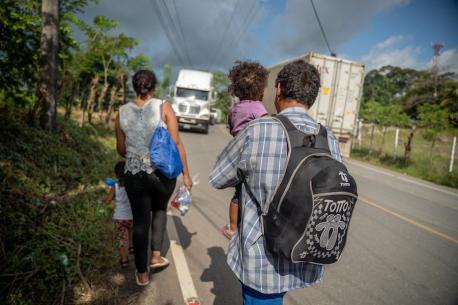
UNICEF Report: The Changing Face of Child Migration in Latin America and the Caribbean
One in four people on the move in Latin America and the Caribbean is a child, setting a new record amid violence, instability and climate change.
Summary:
In the past decade, the nature of migration in Latin America and the Caribbean Region has changed dramatically.
“Gang violence, instability, poverty and climate-related events are, alarmingly, gripping the region and pushing more children from their homes,” said UNICEF Latin America and the Caribbean Director Garry Conille. “More and more children are on the move, of an increasingly young age, often alone and from diverse countries of origin, including from as far away as Africa and Asia. When they cross several countries and sometimes the entire region, disease and injury, family separation and abuse may plague their journeys and, even if they make it to their destination, their futures often remain at risk.”
Despite these hazards, the proportion of children moving along major migration routes in Latin America and the Caribbean continues to grow. Children make up 13 percent of the world's migrant population, but in this region, about 25 percent of people on the move are children, up from 19 percent in 2019.
The physical risks along migration routes are innumerable, especially for children. Children may encounter violence, exploitation and abuse. The terrain they must traverse can be equally dangerous.
The Darien jungle is one such migration hot spot. A narrow strip of land, the Darien jungle connects North and South America between Colombia and the Isthmus of Panama. The Darien is a rugged environment with dense jungles, rushing rivers, treacherous hills and vast swamps with knee-deep mud.
It is also home to venomous snakes, fire ants and jaguars. But every year, the number of migrants seeing it as the only viable pathway north grows.
In 2021, at least 29,000 children made the perilous crossing. That number grew to an estimated 40,000 children in 2022. In the first seven months of 2023, over 60,000 children have crossed the Darien jungle, half of them under age 5.
“My favorite part was leaving the jungle because it’s a nightmare in there,” said 8-year-old Angela*, who walked through the Darien jungle in 2022. During the journey, she and her 10-year-old sister were separated from their parents and wandered lost for two days before rejoining them. The family traveled for more than 40 days to reach Guatemala before continuing to their destination.
Angela and her sister are part of another alarming trend. At the Darien Gap and other key transit points, up to 91 percent of the children making these perilous journeys are under 11 years old.
In this Child Alert, UNICEF examines the changing dynamics and challenges to national migration policies and humanitarian responses in countries of origin, transit and destination. Looking at child migration in the key regions of northern Central America and Mexico, Haiti and Venezuela, UNICEF uncovers the factors driving child migration, the risks and hardships children face, and enumerates the steps and policies needed to ensure their safety and well-being.
*Name changed